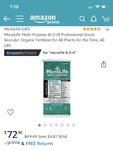My worry about blending in an organic fertilizer is the odor will attract more than just birds. We have squirrels, rodents, and racoons that dig around in pots, and are very attracted to organic odors. I don't know the fauna of Brazil that well, but you are likely to have your complement of rodents and members of the weasel family that will venture into urban areas and comb through your garbage, and dig in flower pots looking for grubs or whatever. We get cats wanting to use our trees as litter pans, and opossums looking for earthworms, we get skunks too.
Actually "Mr Skunk" and I have a cordial relationship. He apparently lives under my front porch. At night I always pause and make some noise before descending the stairs, and walking along the hedgerow in front of the house on my way to the car. Often the skunk is nearby. If I don't startle him, he just walks away. He has not threatened to spray me in a few years. They shift their weight back and forth between their front feet just before they spay. If you see that, just back up, they will usually turn and run away if you give them room to do so. .








